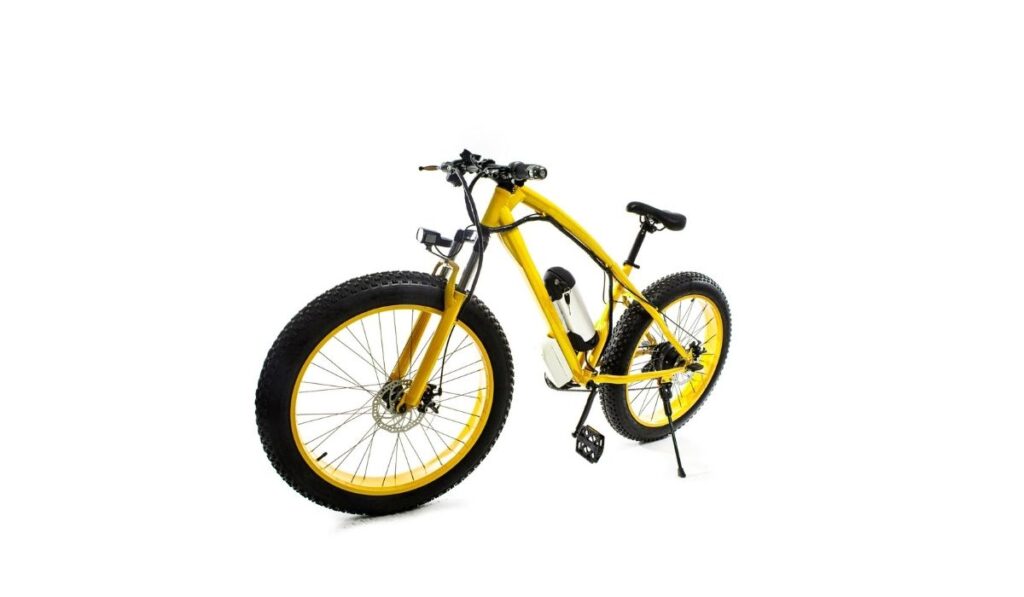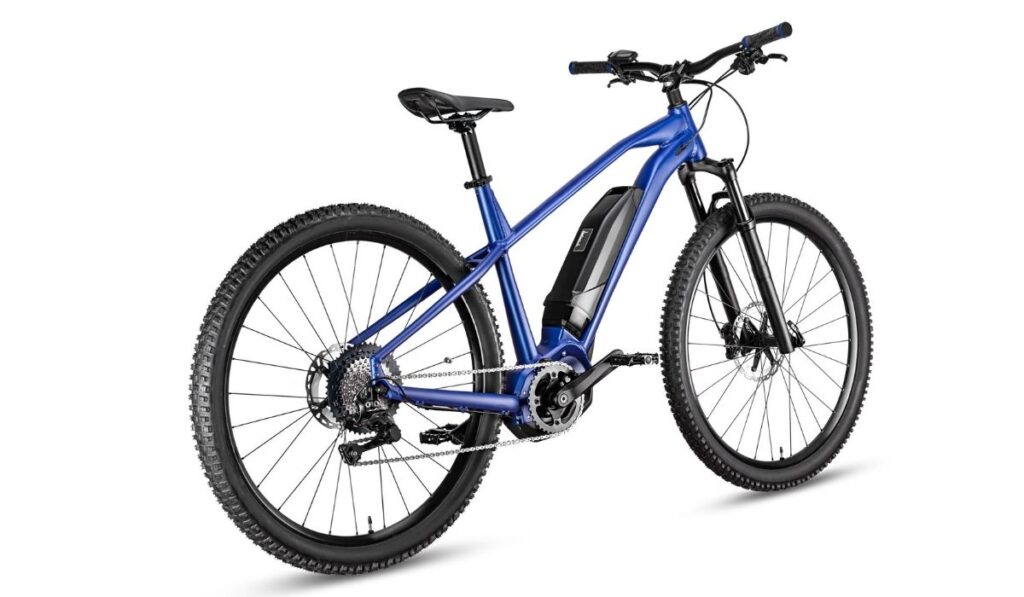If you’ve looked into bikes or electric bikes, you might have come across different suspension types. Names like full-suspension and hardtail sound straight out of a video game. So, what exactly is a full-suspension bike?
Full-suspension bikes have a front fork and rear shock suspension system. These bikes are typically heavier, more comfortable, and better suited for rough terrain than hardtail bikes. Riders who enjoy technical and rugged terrain will benefit from a full-suspension bike.
We all know different bike styles are going to serve other purposes. With full-suspension bikes being better suited for rough terrain, what are hardtails good for? Does your preferred riding style require a double suspension bike? Read on for everything you need to know!
What Exactly Does a Full-Suspension E-Bike Mean?

To understand what a full-suspension e-bike is, we need to first understand how suspension systems work.
A suspension system can consist of a fork in the front and a shock in the back. The fork holds the front wheel, and the shock is incorporated into the frame, controlling the back wheel. This system adds for more comfort, handling, traction, and enjoyability when riding.
Full-suspension, double suspension, or “full sus” bikes have both a fork and a shock. Hardtail bikes will only have a suspension fork.
A full-suspension bike to look at is the eAhora Rurui 750W Electric Bike (on Amazon). The rear suspension can absorb up to 750lbs of pressure, allowing you to tackle craggy terrain while keeping your wheels on the ground. The front suspension is adjustable, meaning you can customize it for pavement or trails.
How Important Is Suspension on a Bike?
The right amount, type, and quality of suspension on a bike highly depend on its user. Riders who are tackling rough terrain, steep hills, and high speeds will benefit from better suspension. For more casual riders, the suspension won’t be as necessary.
Electric bikes and E-MTBs benefit from suspension systems. Both these bikes travel at higher speeds than conventional bicycles. A solid suspension in place allows for a smoother and more enjoyable riding experience.
Highly technical terrain with rock gardens, roots, logs, drop-offs, and more are where full-suspension bikes shine. Hardtails are better suited for smooth terrain like winding single tracks.
So, who benefits the most from a full-suspension bike, and do you need one? If you want to tackle highly technical terrain and push your abilities, you should opt for a full-suspension bike. Trail features such as wallrides, tight turns, and other obstacles allow a full-suspension bike to shine to the fullest.
Are Full-Suspension E-Bikes Worth It?

Full-suspension e-bikes can cost a pretty penny. These bikes are meant to tackle the most technical varieties of terrain and require the parts to match. This price tag might have you wondering if a full-suspension bike is really worth the investment.
Full-suspension e-bikes will be more valuable to those willing to spend a bit more and seeking to tackle highly technical terrain. Some advantages to full-suspension bikes can include:
Faster in highly technical terrain: By now, you should know full-suspension bikes are better suited for rougher terrain. But, these bikes are also faster in this terrain type compared to hardtails. If you want to tackle techy trails and also keep pace, go with a full sus bike.
Less fatigue: Since full-suspension bikes have two shocks, they absorb twice the amount of vibrations than hardtails. This absorption allows for less fatigue, letting you ride longer and more comfortably.
More control: The greater traction and dual suspension allows for more control. With full-suspension bikes, you’ll be able to weave in and out of trees and come to full stops faster than hardtail bikes.
Are Full-Suspension Bikes More Comfortable?
Yes, double suspension bikes can allow for a more comfortable riding experience with more traction. This bike style can tackle rougher terrains and can give new riders the confidence they need when doing so.
So, what then are the benefits of hardtail bikes?
Are Hardtails Better Than Full Suspension?
The short answer to whether or not hardtail e-bikes are better is: it depends. Your perfect bike depends on your riding style, needs, and preferences. However, hardtails are cheaper, lighter, require less maintenance, and more!
Hardtails are cheaper: Hardtail bikes are generally cheaper than their full-suspension counterparts. The total cost goes down without the addition of a rear shock, making this a budget-friendly bike option.
Hardtails are lighter: Hardtails can be less heavy than full-suspension bikes. The additional rear shock on full-suspension bikes can add a decent amount of weight. This weight can change the riding experience and style.
Hardtails require less maintenance: Hardtail bikes have fewer parts than a full sus bike. Fewer parts equal less maintenance, which means fewer maintenance costs. When you’re mainly riding rough terrain, maintenance is going to be a regular occurrence.
Hardtails are better for smoother rides: If you want to zip down smooth trails at higher speeds, you might want to go for a hardtail. Hardtails are worse on rough terrain, but they can fly through smooth surfaces with ease.
Hardtails require some skill: Hardtails allow for a rougher, harder, and less comfortable ride. This style of riding forces you to perform at a higher level. Hardtails can help you learn better line choice, proper speeds, and how to bunnyhop without the added suspension.
An example of a hardtail bike would be the ANCHEER 26” Electric Mountain Bike (on Amazon). This bike only has a front suspension, making it suitable for single and double track. It’s also in the budget-friendly price range. The full-suspension bike we mentioned earlier is over double the price!
Are Full-Suspension Bikes Slower?
One of the most common advantages listed for hardtails is their potential for higher speeds. With a lighter and more efficient design, it makes sense you would be able to go faster. But the heavier older brother, full-sus bikes, can perform as well.
Full-suspension bikes may go downhill faster than hardtail bikes. This added speed is due to the extra weight from the rear shock. On the other hand, climbing hills with a full-sus bike is going to take significantly more time and energy than with a hardtail.
For example, the Full-Suspension PASELEC Electric Bike (on Amazon) weighs 72lbs. This hardtail bike by ANCHEER (also on Amazon) only weighs around 52lbs. You can see how a twenty-pound difference can change the riding style significantly.
For technical terrain, a full sus bike allows you to tackle it with ease. Hardtails are going to take a longer time to cover these trails, even with excellent line choice.
Hardtails will travel much faster on smoother trails. On top of that, hardtails will not only be faster but be more efficient with this trail type.
So, which bike is faster? Like our other answers, it depends. Full-suspension bikes are going to be slower on uphill climbs and smooth terrains. Hardtail bikes are going to have a harder time tackling rough terrain and may reach a lower speed on downhills.
Final Verdict
If you’re still asking yourself, “Is a full-suspension e-bike right for me?,” consider factors beyond your budget. Yes, full-suspension bikes are more expensive, but they can be an excellent choice for some riders.
Does the idea of traversing craggy rock gardens filled with 8ft drop-offs get your blood burning? Then we recommend a full-suspension electric bike!
